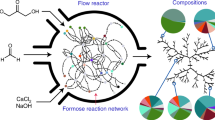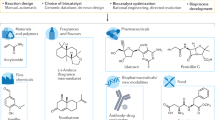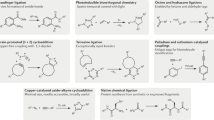Abstract
It is probable that nearly every natural product structure results from interactions between organisms. Symbiosis, a subset of inter-organism interactions involving closely associated partners, has recently provided new and interesting experimental systems for the study of these interactions. This review discusses new observations about natural product function and structural evolution that emerge from the study of symbiotic systems. In particular, these advances directly address long-standing 'how' and 'why' questions about natural products, providing fundamental insights about the evolution, origin and purpose of natural products that are inaccessible by other methods.
This is a preview of subscription content, access via your institution
Access options
Subscribe to this journal
Receive 12 print issues and online access
$259.00 per year
only $21.58 per issue
Buy this article
- Purchase on Springer Link
- Instant access to full article PDF
Prices may be subject to local taxes which are calculated during checkout





Similar content being viewed by others
References
Newman, D.J. & Cragg, G.M. Natural products as sources of new drugs over the last 25 years. J. Nat. Prod. 70, 461–477 (2007).
Simmons, T.L. et al. Biosynthetic origin of natural products isolated from marine microorganism-invertebrate assemblages. Proc. Natl. Acad. Sci. USA 105, 4587–4594 (2008).
Haygood, M.G., Schmidt, E.W., Davidson, S.K. & Faulkner, D.J. Microbial symbionts of marine invertebrates: opportunities for microbial biotechnology. J. Mol. Microbiol. Biotechnol. 1, 33–34 (1999).
Smith, D.C. Symbiosis research at the end of the millenium. Hydrobiologia 461, 49–54 (2001).
Margulis, L. The Origin of Eukaryotic Cells (Yale University Press, New Haven, 1971).
Wahl, M. & Mark, O. The predominantly facultative nature of epibiosis: experimental and observational evidence. Mar. Ecol. Prog. Ser. 187, 59–66 (1999).
Shigenobu, S., Watanabe, H., Hattori, M., Sakaki, Y. & Ishikawa, H. Genome sequence of the endocellular bacterial symbiont of aphids Buchnera sp. APS. Nature 407, 81–86 (2000).
Hotopp, J.C. et al. Widespread lateral gene transfer from intracellular bacteria to multicellular eukaryotes. Science 317, 1753–1756 (2007).
Piel, J. Metabolites from symbiotic bacteria. Nat. Prod. Rep. 21, 519–538 (2004).
Schmidt, E.W. From chemical structure to environmental biosynthetic pathways: navigating marine invertebrate-bacteria associations. Trends Biotechnol. 23, 437–440 (2005).
Visick, K.L., Foster, J., Doino, J., McFall-Ngai, M. & Ruby, E.G. Vibrio fischeri lux genes play an important role in colonization and development of the host light organ. J. Bacteriol. 182, 4578–4586 (2000).
Lopanik, N., Lindquist, N. & Targett, N. Potent cytotoxins produced by a microbial symbiont protect host larvae from predation. Oecologia 139, 131–139 (2004).
Kellner, R.L.L. & Dettner, K. Differential efficacy of toxic pederin in deterring potential arthropod predators of Paederus (Coleoptera: Staphylinidae) offspring. Oecologia 107, 293–300 (1996).
Toshima, H. et al. Prevalence of enteric bacteria that inhibit growth of enterohaemorrhagic Escherichia coli O157 in humans. Epidemiol. Infect. 135, 110–117 (2007).
Lewin, R.A. & Cheng, L. Prochloron: A Microbial Enigma (Chapman and Hall, New York, 1989).
Fisher, C.R. & Trench, R.K. In vitro carbon fixation by Prochloron sp. isolated from Diplosoma virens . Biol. Bull. 159, 639–648 (1980).
Kremer, B.P., Pardy, R. & Lewin, R.A. Carbon fixation and photosynthates of Prochloron, a green alga symbiotic with an ascidian, Lissoclinum patella . Phycologia 21, 258–263 (1982).
Griffiths, D.J. & Thinh, L.V. Transfer of photosynthetically fixed carbon between the prokaryotic green alga Prochloron and its ascidian host. Aust. J. Mar. Freshwater Res. 34, 431–440 (1983).
Alberte, R.S., Cheng, L. & Lewin, R.A. Characteristics of Prochloron ascidian symbioses. 2. Photosynthesis-irradiance relationships and carbon balance of associations from Palau, Micronesia. Symbiosis 4, 147–170 (1987).
Dionisio-Sege, M.L., Shimada, A., Maruyama, T. & Miyachi, S. Carbonic-anhydrase activity of Prochloron sp. isolated from an ascidian host. Arch. Microbiol. 159, 1–5 (1993).
Koike, I., Yamamuro, M. & Pollard, P.C. Carbon and nitrogen budgets of 2 ascidians and their symbiont, Prochloron, in a tropical seagrass meadow. Aust. J. Mar. Freshwater Res. 44, 173–182 (1993).
Koike, I. & Suzuki, T. Nutritional diversity of symbiotic ascidians in a Fijian seagrass meadow. Ecol. Res. 11, 381–386 (1996).
Odintsov, V.S. Nitrogen fixation in Prochloron (Prochlorophyta)-ascidian associations — is Prochloron responsible. Endocytobiosis Cell Res. 7, 253–258 (1991).
Ireland, C.M. & Scheuer, P.J. Ulicyclamide and ulithiacyclamide, 2 new small peptides from a marine tunicate. J. Am. Chem. Soc. 102, 5688–5691 (1980).
Ireland, C.M., Durso, A.R., Newman, R.A. & Hacker, M.P. Anti-neoplastic cyclic peptides from the marine tunicate Lissoclinum patella . J. Org. Chem. 47, 1807–1811 (1982).
Degnan, B.M. et al. New cyclic peptides with cytotoxic activity from the ascidian Lissoclinum patella . J. Med. Chem. 32, 1349–1354 (1989).
Schmidt, E.W. et al. Patellamide A and C biosynthesis by a microcin-like pathway in Prochloron didemni, the cyanobacterial symbiont of Lissoclinum patella . Proc. Natl. Acad. Sci. USA 102, 7315–7320 (2005).
Donia, M. et al. Natural combinatorial peptide libraries in cyanobacterial symbionts of marine ascidians. Nat. Chem. Biol. 2, 729–735 (2006).
Adams, B.J. et al. Biodiversity and systematics of nematode-bacterium entomopathogens. Biol. Control 37, 32–49 (2006).
Brusca, R.C., Brusca, G.J. & Haver, N.J. Invertebrates (Sinauer Associates, Sunderland, Massachusetts, 2003).
Coghlan, A. Nematode genome evolution. WormBook 1–15 (2005).
Goodrich-Blair, H. & Clarke, D.J. Mutualism and pathogenesis in Xenorhabdus and Photorhabdus: two roads to the same destination. Mol. Microbiol. 64, 260–268 (2007).
Paul, V.J., Frautschy, S., Fenical, W. & Nealson, K.H. Antibiotics in microbial ecology. J. Chem. Ecol. 7, 589–597 (1981).
Richardson, W.H., Schmidt, T.M. & Nealson, K.H. Identification of an anthraquinone pigment and a hydroxystilbene antibiotic from Xenorhabdus luminescens . Appl. Environ. Microbiol. 54, 1602–1605 (1988).
Joyce, S.A. et al. Bacterial biosynthesis of a multipotent stilbene. Angew. Chem. Int. Ed. 47, 1942–1945 (2008).
Pettit, G.R. et al. Isolation and structure of bryostatin 1. J. Am. Chem. Soc. 104, 6846–6848 (1982).
Kortmansky, J. & Schwartz, G.K. Bryostatin-1: a novel PKC inhibitor in clinical development. Cancer Invest. 21, 924–936 (2003).
Woollacott, R.M. Association of bacteria with bryozoan larvae. Mar. Biol. 65, 155–158 (1981).
Haygood, M.G. & Davidson, S.K. Small-subunit rRNA genes and in situ hybridization with oligonucleotides specific for the bacterial symbionts in the larvae of the bryozoan Bugula neritina and proposal of “Candidatus endobugula sertula”. Appl. Environ. Microbiol. 63, 4612–4616 (1997).
Kerr, R.G., Lawry, J. & Gush, K.A. In vitro biosynthetic studies of the bryostatins, anti-cancer agents from the marine bryozoan Bugula neritina . Tetrahedr. Lett. 37, 8305–8308 (1996).
Davidson, S.K., Allen, S.W., Lim, G.E., Anderson, C.M. & Haygood, M.G. Evidence for the biosynthesis of bryostatins by the bacterial symbiont “Candidatus Endobugula sertula” of the bryozoan Bugula neritina . Appl. Environ. Microbiol. 67, 4531–4537 (2001).
Hildebrand, M. et al. bryA: an unusual modular polyketide synthase gene from the uncultivated bacterial symbiont of the marine bryozoan Bugula neritina . Chem. Biol. 11, 1543–1552 (2004).
Sudek, S. et al. Identification of the putative bryostatin polyketide synthase gene cluster from “Candidatus Endobugula sertula”, the uncultivated microbial symbiont of the marine bryozoan Bugula neritina . J. Nat. Prod. 70, 67–74 (2007).
Lim-Fong, G.E., Regali, L.A. & Haygood, M.G. Evolutionary relationships of “Candidatus endobugula” bacterial symbionts and their Bugula bryozoan hosts. Appl. Environ. Microbiol. 74, 3605–3609 (2008).
Sharp, K.H., Davidson, S.K. & Haygood, M.G. Localization of 'Candidatus Endobugula sertula' and the bryostatins throughout the life cycle of the bryozoan Bugula neritina . ISME J. 1, 693–702 (2007).
Pavan, M. & Bo, G. Pederin, toxic principle obtained in the crystalline state from the beetle Paederus fuscipes . Curt. Phys. Comp. Oecol. 3, 307–312 (1953).
Kellner, R.L.L. Horizontal transmission of biosynthetic capabilities for pederin in Paederus melanurus (Coleoptera: Staphylinidae). Chemoecology 11, 127–130 (2001).
Piel, J. A polyketide synthase-peptide synthetase gene cluster from an uncultured bacterial symbiont of Paederus beetles. Proc. Natl. Acad. Sci. USA 99, 14002–14007 (2002).
Chapela, I.H., Rehner, S.A., Schultz, T.R. & Mueller, U.G. Evolutionary history of the symbiosis between fungus-growing ants and their fungi. Science 266, 1691–1694 (1994).
Mueller, U.G., Rehner, S.A. & Schultz, T.R. The evolution of agriculture in ants. Science 281, 2034–2038 (1998).
Schlick-Steiner, B.C. et al. Specificity and transmission mosaic of ant nest-wall fungi. Proc. Natl. Acad. Sci. USA 105, 940–943 (2008).
Poulsen, M. & Boomsma, J.J. Mutualistic fungi control crop diversity in fungus-growing ants. Science 307, 741–744 (2005).
Currie, C.R., Poulsen, M., Mendenhall, J., Boomsma, J.J. & Billen, J. Coevolved crypts and exocrine glands support mutualistic bacteria in fungus-growing ants. Science 311, 81–83 (2006).
Gerardo, N.M., Jacobs, S.R., Currie, C.R. & Mueller, U.G. Ancient host-pathogen associations maintained by specificity of chemotaxis and antibiosis. PLoS Biol. 4, 1358–1363 (2006).
Currie, C.R., Scott, J.A., Summerbell, R.C. & Malloch, D. Fungus-growing ants use antibiotic-producing bacteria to control garden parasites. Nature 398, 701–704 (1999); corrigendum 423, 461 (2003).
Currie, C.R., Mueller, U.G. & Malloch, D. The agricultural pathology of ant fungus gardens. Proc. Natl. Acad. Sci. USA 96, 7998–8002 (1999).
Riley, M.A. & Chavan, M.A. Bacteriocins: Ecology and Evolution (Springer, New York, 2007).
Roush, R.F., Nolan, E.M., Lohr, F. & Walsh, C.T. Maturation of an Escherichia coli ribosomal peptide antibiotic by ATP-consuming N-P bond formation microcin C7. J. Am. Chem. Soc. 130, 3063–3069 (2008).
Zamble, D.B., McClure, C.P., Penner-Hahn, J.E. & Walsh, C.T. The McbB component of microcin B17 synthetase is a zinc metalloprotein. Biochemistry 39, 16190–16199 (2000).
Li, Y.M., Milne, J.C., Madison, L.L., Kolter, R. & Walsh, C.T. From peptide precursors to oxazole and thiazole-containing peptide antibiotics: microcin B17 synthase. Science 274, 1188–1193 (1996).
Adams, J., Kinney, T., Thompson, S., Rubin, L. & Helling, R.B. Frequency-dependent selection for plasmid-containing cells of Escherichia coli . Genetics 91, 627–637 (1979).
Chao, L. & Levin, B.R. Structured habitats and the evolution of anticompetitor toxins in bacteria. Proc. Natl. Acad. Sci. USA 78, 6324–6328 (1981).
Riley, M.A. & Wertz, J.E. Bacteriocins: evolution, ecology, and application. Annu. Rev. Microbiol. 56, 117–137 (2002).
Tagg, J.R., Dajani, A.S. & Wannamaker, L.W. Bacteriocins of gram-positive bacteria. Bacteriol. Rev. 40, 722–756 (1976).
Riley, M.A., Goldstone, C.M., Wertz, J.E. & Gordon, D. A phylogenetic approach to assessing the targets of microbial warfare. J. Evol. Biol. 16, 690–697 (2003).
Gordon, D.M., Oliver, E. & Littlefield-Wyer, J. in Bacteriocins: Ecology and Evolution (eds. Riley, M.A. & Chavan, M.A.) 5–18 (Springer, New York, 2007).
Devireddy, L.R., Gazin, C., Zhu, X. & Green, M.R.A. Cell-surface receptor for lipocalin 24p3 selectively mediates apoptosis and iron uptake. Cell 123, 1293–1305 (2005).
Nguyen, T. et al. Exploiting the mosaic structure of trans-acyltransferase polyketide synthases for natural product discovery and pathway dissection. Nat. Biotechnol. 26, 225–233 (2008).
Piel, J. et al. Antitumor polyketide biosynthesis by an uncultivated bacterial symbiont of the marine sponge Theonella swinhoei . Proc. Natl. Acad. Sci. USA 101, 16222–16227 (2004).
Kawaide, H. Biochemical and molecular analyses of gibberellin biosynthesis in fungi. Biosci. Biotechnol. Biochem. 70, 583–590 (2006).
Eyberger, A.L., Dondapati, R. & Porter, J.R. Endophyte fungal isolates from Podophyllum peltatum produce podophyllotoxin. J. Nat. Prod. 69, 1121–1124 (2006).
Puri, S.C., Verma, V., Amna, T., Qazi, G.N. & Spiteller, M. An endophytic fungus from Nothapodytes foetida that produces camptothecin. J. Nat. Prod. 68, 1717–1719 (2005).
Jennewein, S., Wildung, M.R., Chau, M., Walker, K. & Croteau, R. Random sequencing of an induced Taxus cell cDNA library for identification of clones involved in Taxol biosynthesis. Proc. Natl. Acad. Sci. USA 101, 9149–9154 (2004).
Williams, D.C. et al. Intramolecular proton transfer in the cyclization of geranylgeranyl diphosphate to the taxadiene precursor of taxol catalyzed by recombinant taxadiene synthase. Chem. Biol. 7, 969–977 (2000).
Zhou, X. et al. Screening of taxol-producing endophytic fungi from Taxus chinensis var. mairei . Prikl. Biokhim. Mikrobiol. 43, 490–494 (2007).
Wang, J. et al. Taxol from Tubercularia sp. strain TF5, an endophytic fungus of Taxus mairei . FEMS Microbiol. Lett. 193, 249–253 (2000).
Li, J.Y., Strobel, G., Sidhu, R., Hess, W.M. & Ford, E.J. Endophytic taxol-producing fungi from bald cypress, Taxodium distichum . Microbiology 142, 2223–2226 (1996).
Strobel, G. et al. Taxol from Pestalotiopsis microspora, an endophytic fungus of Taxus wallachiana . Microbiology 142, 435–440 (1996).
Stierle, A., Strobel, G. & Stierle, D. Taxol and taxane production by Taxomyces andreanae, an endophytic fungus of Pacific yew. Science 260, 214–216 (1993).
Fujii, I. in Comprehensive Natural Products Chemistry (eds. Barton, D.N.K. & Meth-Cohn, O.) 409–441 (Elsevier, New York, 1999).
Poeaknapo, C., Schmidt, J., Brandsch, M., Drager, B. & Zenk, M.H. Endogenous formation of morphine in human cells. Proc. Natl. Acad. Sci. USA 101, 14091–14096 (2004).
Donia, M.S., Ravel, J. & Schmidt, E.W. A global assembly line for cyanobactins. Nat. Chem. Biol. 4, 341–343 (2008).
Schmidt, E.W., Obraztsova, A.Y., Davidson, S.K., Faulkner, D.J. & Haygood, M.G. Identification of the antifungal peptide-containing symbiont of the marine sponge Theonella swinhoei as a novel delta-proteobacterium, “Candidatus Entotheonella palauensis . Mar. Biol. 136, 969–977 (2000).
Schmidt, E.W., Bewley, C.A. & Faulkner, D.J. Theopalauamide, a bicyclic glycopeptide from filamentous bacterial symbionts of the lithistid sponge Theonella swinhoei from Palau and Mozambique. J. Org. Chem. 63, 1254–1258 (1998).
Taylor, M.W., Radax, R., Steger, D. & Wagner, M. Sponge-associated microorganisms: evolution, ecology, and biotechnological potential. Microbiol. Mol. Biol. Rev. 71, 295–347 (2007).
Bruck, W.M., Sennett, S.H., Pomponi, S.A., Willenz, P. & McCarthy, P.J. Identification of the bacterial symbiont Entotheonella sp. in the mesohyl of the marine sponge Discodermia sp. ISME J. 2, 335–339 (2008).
Schirmer, A. et al. Metagenomic analysis reveals diverse polyketide synthase gene clusters in microorganisms associated with the marine sponge Discodermia dissoluta . Appl. Environ. Microbiol. 71, 4840–4849 (2005).
Carroll, A.R. et al. Patellins 1–6 and trunkamide A: novel cyclic hexa-, hepta- and octa-peptides from colonial ascidians, Lissoclinum sp. Aust. J. Chem. 49, 659–667 (1996).
Salomon, C.E. & Faulkner, D.J. Localization studies of bioactive cyclic peptides in the ascidian Lissoclinum patella . J. Nat. Prod. 65, 689–692 (2002).
Long, P.F., Dunlap, W.C., Battershill, C.N. & Jaspars, M. Shotgun cloning and heterologous expression of the patellamide gene cluster as a strategy to achieve sustained metabolite production. ChemBioChem 6, 1760–1765 (2005).
Jones, B.V. & Marchesi, J.R. Transposon-aided capture (TRACA) of plasmids resident in the human gut mobile metagenome. Nat. Methods 4, 55–61 (2007).
Jones, B.V. & Marchesi, J.R. Accessing the mobile metagenome of the human gut microbiota. Mol. Biosyst. 3, 749–758 (2007).
Casas, V. et al. Widespread occurrence of phage-encoded exotoxin genes in terrestrial and aquatic environments in Southern California. FEMS Microbiol. Lett. 261, 141–149 (2006).
Dinsdale, E.A. et al. Functional metagenomic profiling of nine biomes. Nature 452, 629–632 (2008).
Andrianasolo, E.H. et al. Isolation of swinholide A and related glycosylated derivatives from two field collections of marine cyanobacteria. Org. Lett. 7, 1375–1378 (2005).
Bewley, C.A., Holland, N.D. & Faulkner, D.J. Two classes of metabolites from Theonella swinhoei are localized in distinct populations of bacterial symbionts. Experientia 52, 716–722 (1996).
Chavan, M., Rafi, H., Wertz, J., Goldstone, C. & Riley, M.A. Phage associated bacteriocins reveal a novel mechanism for bacteriocin diversification in Klebsiella . J. Mol. Evol. 60, 546–556 (2005).
Wertz, J.E. & Riley, M.A. Chimeric nature of two plasmids of Hafnia alvei encoding the bacteriocins alveicins A and B. J. Bacteriol. 186, 1598–1605 (2004).
Acknowledgements
Our work on symbiosis is funded by the US National Institutes of Health (GM071425) and by the US National Science Foundation (EF-0412226) (subcontract from University of Maryland). The author thanks M.G. Haygood (Oregon Health and Science University) for critically reading an early version of the manuscript.
Author information
Authors and Affiliations
Corresponding author
Rights and permissions
About this article
Cite this article
Schmidt, E. Trading molecules and tracking targets in symbiotic interactions. Nat Chem Biol 4, 466–473 (2008). https://doi.org/10.1038/nchembio.101
Published:
Issue Date:
DOI: https://doi.org/10.1038/nchembio.101
This article is cited by
-
Recent Advances of Marine Sponge-Associated Microorganisms as a Source of Commercially Viable Natural Products
Marine Biotechnology (2022)
-
Isolation and identification of antimicrobial metabolites from sea anemone-derived fungus Emericella sp. SMA01
Journal of Oceanology and Limnology (2021)
-
Bacteria as genetically programmable producers of bioactive natural products
Nature Reviews Chemistry (2020)
-
Secondary Metabolites Produced by Honey Bee-Associated Bacteria for Apiary Health: Potential Activity of Platynecine
Current Microbiology (2020)
-
Ultrastructural evidence for nutritional relationships between a marine colonial invertebrate (Bryozoa) and its bacterial symbionts
Symbiosis (2018)



